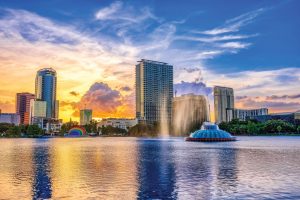A City of the Future
The future is upon us—and the City of Orlando is making the most of it with a comprehensive plan that focuses on innovations in technology, sustainability, transportation, health and safety, utilities, culture and more.

Central Florida has a reputation for innovation, and with so much accomplished and in progress, there is even more yet to come. Through commercial partnerships, dedication to citizens and constant analysis of trends inside and outside of the area, Orlando increasingly surpasses the standard of modernization.
As tourism has returned to pre-pandemic levels and with residency on the rise, Orlando has been working on a community-focused master plan since 2020 with a goal of becoming a “future-ready city,” according to Mayor Buddy Dyer. This is referred to as the Growth Management Plan (GMP). The proactive approach not only encourages, but is built upon input from the community.
To that end, Mayor Dyer is currently working alongside Orange County Mayor Jerry Demings to accommodate one of the most rapidly growing cities in the nation through infrastructure, housing, transportation and economic opportunities. Orange County’s Vision 2050 comprehensive plan provides a blueprint for the future that is aligned with Orlando’s GMP.
According to Mayor Demings, there are approximately 400 new residents each week and according to Mayor Dyer, Orlando gained 5,700 new residents in 2023. Both mayors serve on several boards together to seek correlative solutions that maintain the shared goal of an advanced quality of life for their constituents in light of the substantial population increase.
“By cultivating an ecosystem that can support a number of industries at the highest caliber, we strengthen our city’s reputation as a city for everyone—where every profession and interest can come to find high wage, high value jobs and have an unmatched quality of life. The more we grow that ecosystem, the stronger our economy becomes … it’s all part of a bigger picture that is one symbiotic relationship that will continue to drive our city into the future and allow us to adapt accordingly,” Mayor Dyer explains. “Beginning in January of this year to today, our city has more than 400 development projects in the pipeline, which include a diverse mix of single and multifamily housing, health care, retail, services, education, tech spaces and mixed-use development.”
The plan entails efforts to unite technological advancements with already existing implements in the community, with a result that is both visual and structural. Divided into seven focus areas—connectivity, mobility, energy, health and safety, materials, placemaking and water—the master plan is all-encompassing and described as a people-first initiative. “Smart City” efforts consist of utilizing the newest technology to best serve the community in its entirety.
“One major initiative is our emphasis on Smart Cities development, infrastructure development, the utilization of artificial intelligence and the investment we are making in transportation, public safety and related responses, health care, energy and sustainability initiatives. Initiatives are also equally important in an education aspect, and working with our educational systems and industry partners will provide the pipeline of talent that will be needed to go to work in these various emerging industries,” explains Mayor Demings.
In the modern age, a smartphone is a necessity for work and school in addition to being the standard method of communication. Especially in an emergency, citizens should have equal access to public safety and services. Mayor Demings points out that as technology modernizes, the efficiency it provides benefits the community as a whole when met with heightened accessibility for everyone. He exemplifies emergency call centers that are able to receive a more accurate location to attend to residents faster.
“Just recently, the Orange County Fire Rescue Department started responding and deploying whole blood transfusions in the field, which provides vital life-saving opportunities for persons who are critically injured, rather than have to wait until they get to the hospital to get blood. We’re the only first response agency within the region—one of very few within the nation—that allows our paramedics in the field to administer whole blood products, and that saves time and it saves lives,” he affirms.
The newest in communication technology is being combined with medical innovation in what is often a life-saving initiative. Local hospitals and colleges of medicine are aiming to address the shortage of health care professionals by providing education and training in which medical technology is pivotal. This fall will mark the opening of Orlando College of Osteopathic Medicine, which is the first of its kind in Central Florida.
The emphasis on connectivity is intended to incorporate digital resources and expand their accessibility. The city has a history of these efforts, notably with online portals for efficient and convenient city services, as well as within transportation. With these tools, safety and education help achieve transparency from and collaboration with the local government that benefits residents. In bridging the “digital divide,” as the plan entails, residents without internet access will still be able to obtain important city information on data, services and opportunities.
Current projects in the digital scope include 5G technology and a one-year, no-cost WiFi hotspot program with the additional opportunity to borrow a tablet device for up to two weeks. Resilience hubs that are designed to assist during natural disasters also have the capacity to provide WiFi and power to low-to-moderate income areas. In a partnership with the University of Central Florida (UCF), the city is working to build an accompanying mobile resilience hub.
And as an area known for entertainment, Mayor Dyer is exploring the endless possibilities of Metaverse technology through Orlando’s role as a “MetaCenter.” While this technology can advance recreation like next-generation video games, it can also provide simulations, artificial intelligence and models that have proven beneficial to companies, training and education.
Free digital literacy workshops and training will be an essential part of this internal strategy that recognizes that digital access is a modern necessity. Upcoming plans include upgrading the device checkout program to laptops in addition to tablets, wider expansion of public WiFi and device donations. This citizen-centric initiative is in place to provide opportunities regardless of economic background, propelling the city forward without leaving anyone behind.
In additionally expanding the nonprofit community in Orange County, Mayor Demings works with a diverse group of organizations in a partnership that addresses “impact measurement, financial management, risk management, fundraising and teaching them how to better tell their stories.” The goal is to strengthen and empower the work of the 100 participating nonprofits with support from the local government.
Remaining cognizant of the needs of all residents, Mayor Dyer has placed a focus on designating Orlando as an AARP Age-Friendly Community. This initiative is divided into categories similar to those within the GMP such as transportation, housing and civic engagement, but is specially designed to ensure the health and happiness of every age group. Advancements in this initiative include the creation of high-quality affordable housing for seniors as well as rehabilitation centers to allow aging in place. New community programs hosted by experts like the Orlando Fire Department are tailored to seniors to prepare them for an emergency.
A major part of the plan’s strategy is continuous assessment of its progression, and another upcoming project is the designation of a “digital twin” of the city to monitor the infrastructure and environment. This will ideally help the city predict and visualize impact with a model that exactly mirrors Orlando’s buildings and utility systems. Similarly, the goal of designing a virtual reality map experience for area landmarks energizes positive community engagement and mobility.
Placemaking intends to promote civic engagement with structures designed for cultural and social implications as well as fundamental objectives like affordable housing. This, too, stresses a greener future for the city with low-impact development and protected open spaces. With workforce development as another focus, the Orlando City Council approved funding to expand local entrepreneurial collaboration with the city and with new technology.
Transportation goes hand-in-hand with connectivity, and nothing screams “futuristic” more than a self-driving car. Although still in the works, Orlando’s membership of the Central Florida Automated Vehicle Partnership and its association with the Florida Department of Transportation, UCF, MetroPlan and LYNX places the city on a fast trajectory for autonomous vehicles to account for 10% of public transit by 2040. Additionally, a two-part plan for advanced air mobility has assessed and planned for electric Vertical Takeoff and Landing (eVTOL) technologies that fulfill the urgency for more sustainable aircraft functionality.
Brightline is a major part of the city’s advancement toward urbanization. The rail route connects Central Florida to South Florida, and Mayor Demings is hopeful that partnerships between other transportation companies, the city and future investments will propel the transportation industry even further forward.
As a metropolitan environment undergoing further urbanization, the city is focused on reducing its energy consumption and remaining cognizant of utilities and materials. This includes strategies for a “zero waste” community with diversified recycling and composting programs and education. Each detail of the plan is either connected to or contingent upon another; so, for instance, designing new modes of transporting waste is accompanied by objectives to reduce gas emissions during the process.
Mayor Dyer explains that the city’s 149-year history has withheld the everlasting values of protecting its natural and historical attributes, as its designation as “The City Beautiful” implies. While moving forward, Orlando will also preserve and celebrate its past as a city adored by its residents and visitors alike.
“The city faces many challenges, but one concept remains clear: Orlando must define and strengthen the key elements that, working together, will make ‘The City Beautiful’ an even better place to live in the year 2050. This requires an understanding not only of Orlando’s historical role, but also the city’s role within the Central Florida region,” says Mayor Dyer.
“The 1980 GMP established the basic growth management framework necessary for Orlando to evolve into a vibrant and diversified regional center. In 1985 and 1991, the city further detailed the actions needed to achieve this regional center while also protecting neighborhoods and enhancing quality of life. And with the adoption of this GMP update in 2024, Orlando continues to define its vision for the future, a vision based on community consensus and shared values.”









